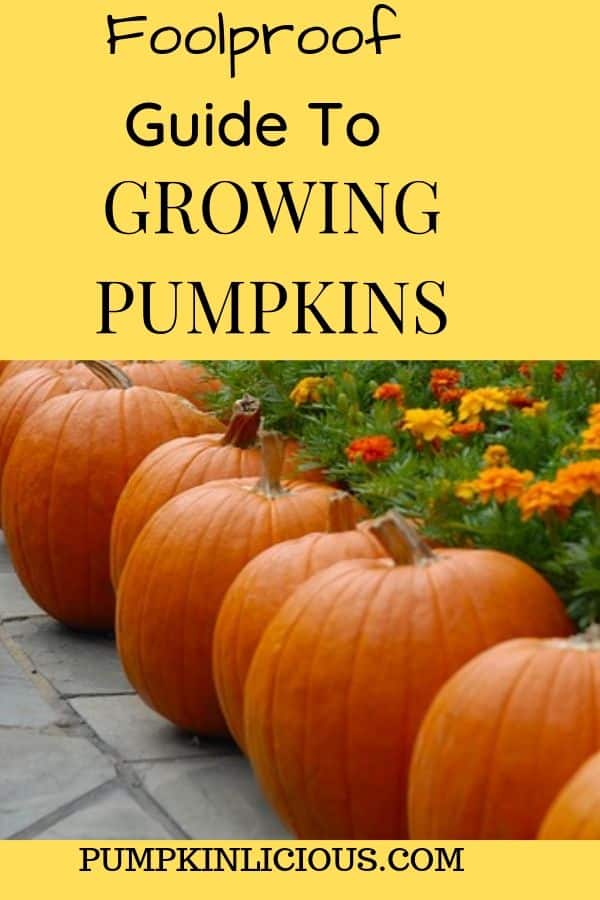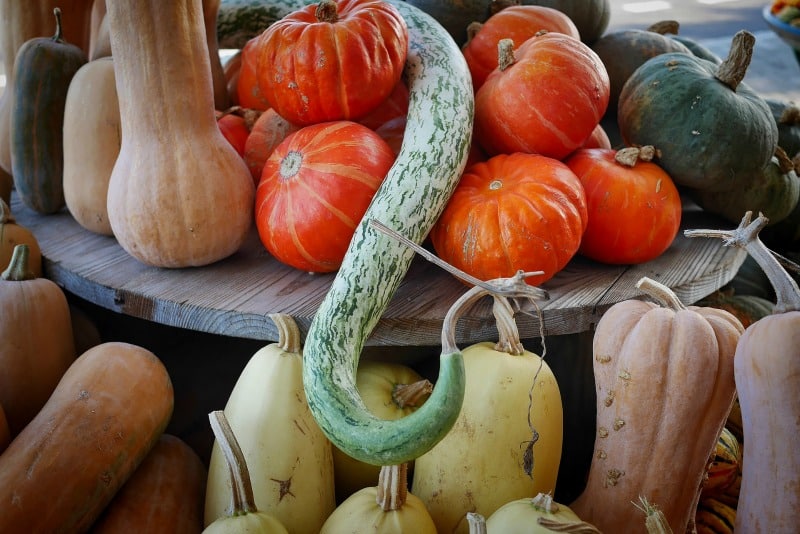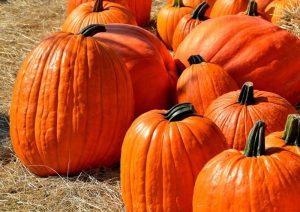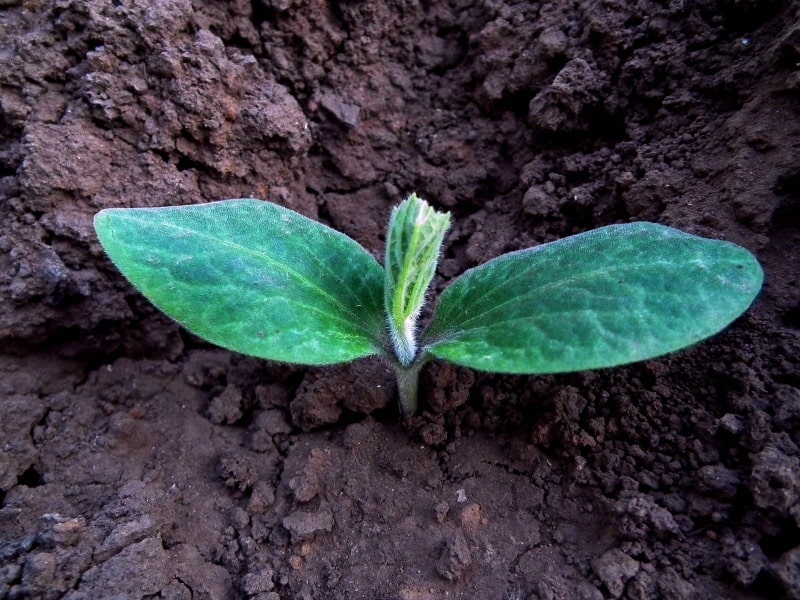Growing pumpkins is easy and fun, and they have a thousand uses once they are harvested.
If you want to know how to grow pumpkins for beginners in 2022 check out the pumpkin growing tips below.

Pumpkins have been grown in the United States for over 5000 years, so it's not surprising that they are so popular and that they have so many uses. There are countless pumpkin recipes for all tastes.
And all over the world giant pumpkin growing has become a huge hobby for many and is highly competitive.
Whatever you want to do with them, you will find out how to grow pumpkins here. You will find information of where to grow them, when to grow them, what weather conditions you need, what soil is required and some information about the different types of seeds and pests that affect them.
Where To Grow Pumpkins
Growing pumpkins takes quite a bit of space. If you want to grow regular size pumpkins, you will need at least 6ft x 6ft of space (a minimum of 36 sq ft).
Otherwise you might want to consider one of the smaller pumpkins or bush pumpkins which can be grown in a smaller space or even in a pot.
I need a tutorial on growing pumpkins in small spaces as people with tiny gardens keep asking for advice! Just recently I did explore growing pumpkins in pots
Growing squash instead of pumpkins might also be an alternative. There is a huge variety of different squashes, many of which are fairly small and easy to grow.
Squashes tend to have softer skins and don't keep so long. They include such diverse vegetables as butter nut squashes, acorn squashes, marrows and zucchinis, often also known as summer squashes.
How To Grow Pumpkins for Beginners Tips
If you are growing Queensland Blue Pumpkins or Kent pumpkins I have some additional tips
Choose a sunny spot -Pumpkin Sun Requirements
As long as you have a sunny spot which gets at least 6 hours of sunlight a day, you can grow a pumpkin plant pretty much anywhere.
I used to grow them amongst my other plants at the back of the garden, between my shrubs.
A few times I forgot to keep an eye on them, and they ended up climbing up into the trees and over my shrubs. But you can train them in a spiral or a straight line and peg them down to keep them under control.
They never seemed to mind me ruthlessly pulling them out of the trees anyway, and could tolerate quite a bit of damage and still grow perfectly good pumpkins.
In fact, once the plant has got to a certain size, it's not a bad idea to cut back some of the growing tips so the plant concentrates on putting its energies into the fruits - ie your pumpkins rather than tons of green foliage.
Just be careful not to tramp about too much over the soil while you are cutting back or training your vines as you will damage the delicate root system under the soil. And I suggest you wear gloves as pumpkin vines are a little prickly.
Find a sheltered spot
One last tip about where to plant your pumpkins, don't plant them in a really windy spot. Their large leaves can be ripped or damaged in high winds. Make sure they are quite sheltered from the strongest breezes.
Of course you need to make sure bees can get access too in order to pollinate or you will have no female pumpkin flowers! Bees do not like windy areas and will not visit to pollinate.
When Is The Best Time To Grow Pumpkins?
Pumpkins don't like the cold, so make sure any danger of frost is past and plant out in the spring. You can start your plants indoors or under glass if you want to get a head start.
In tropical areas you can plant pumpkins right through into summer. Another consider on when to plant pumpkin seeds is when you want to harvest them.
Find some advice on when is best to plant pumpkin seeds for Halloween and Thanksgiving
The Best Soil For Pumpkins
Being such large plants with such big fruits, pumpkins logically need a lot of food and water. So prepare the soil with lots of manure, compost and fertilizer before planting.
As well as feeding the plant, the organic matter in the soil will help to retain water. It's best to make a big mound of well mixed soil, organic matter, compost and manure and create a channel around it to retain water.
Some people just plant their pumpkin seeds in the top of the compost heap and grow them there. Actually I've grown a few by accident there in the past, as the pumpkin debris from my kitchen has had seeds in it and they've just taken off by themselves.
The only trouble with that is you don't know what variety you're going to end up with, and it does make access to your compost heap a little tricky for a few months! Therefore I am not totally sure I would recommend growing pumpkins on compost heap
Find out more about the best fertilizer for pumpkins and when you need to apply it!
How to grow pumpkins - planting pumpkin seeds
Make a mound out of compost, plant 5 or 6 seeds on top of the mound and cover with about 1 inch of soil. Leave about 4ft between mounds and 6ft between rows if you're growing more than one or two plants.
Water gently, being careful not to wash the top layer of soil off. The idea of planting more seeds than you need is so that you can choose the strongest one, and have a couple of extras for the slugs 😉
Package of 100 Seeds, Connecticut Fields Pumpkin (Cucurbita pepo) Non-GMO Seeds by Seed Needs

Choose from a huge range of Pumpkin seeds here
It's a good idea to protect the young seedlings for a while. You can put cut down plastic bottles with the top open over them to create a barrier from pests.
Do pumpkins like coffee grounds?
I find that sprinkling coffee grounds around the young pumpkin plants tends to deter the slugs and other pests.
You can also leave out a saucer of beer to attract the slugs away from your plants, if you can bear to see the poor drowned creatures the next morning.
Once the seedlings are up, and a few inches high, you can thin them out to one or two plants.
Here you can find more details about planting pumpkins seeds, and where to get them.
Feeding and watering the growing pumpkins
If you've prepared your soil well enough, your pumpkins shouldn't need much care and attention during the growing season apart from a good watering on a regular basis if it doesn't rain.
They need a lot of water, but they are not going to curl up and die if you miss a few days. Their large leaves shade the ground and their root system can gather water from a large area.
So don't over water, or let the water pool into muddy patches. Make sure the top of the soil is dry before you water again. Water in the early morning or later in the evening so that the water doesn't just evaporate in the heat.
Try not to wet the leaves, as this will encourage powdery mildew and other fungal problems.
Once the fruits have appeared, you can give a liquid feed every two weeks or so if you want large pumpkins. Fish emulsion is a good rich fertilizer which they love. My dog Jessie, adores the smell of it too.
Personally I never bothered to fertilize much, and I still got quite good pumpkins for cooking. No doubt my yield could have been much better if I wasn't such a lazy gardener!
You'll need to feed them regularly if you are going for giant pumpkins of course, or have particularly poor soil.
TIP - If you want to grow pumpkins with large fruits - thin them out to only 2 or 3 per plant, otherwise leave a few more on the vine.
Find some tips on how to GROW GIANT PUMPKINS from seeds
Pumpkin pests and diseases
Pumpkins are not prone to a lot of pests and diseases and once they are past the seedling stage they can pretty much outgrow anything that attacks them. If you grow healthy plants in rich soil, keep the weeds down and keep a look out for any beetles or bugs you should be fine.
Yellow Sticky Aphid Whitefly Trap Pack of 15
This is carried by aphids, so if you have a lot of aphids, put out yellow sticky traps. You can diagnose mosaic virus by the deformed leaves and fruits it causes, and the light green or yellow discoloring around the leaf veins.
If you get this disease the only solution is to pull out the plants and burn them.
To avoid pumpkin plant diseases in the future, try to obtain disease resistant cultivars of the variety you want.
Also don't grow members of the cucumber family (pumpkins, squashes, melons, cucumbers) on the same patch every year. This can allow pest numbers to increase dramatically.
I don't like using insecticides, especially as they will also kill the bees that are essential for pollinating the fruit. If you have no bees there are other ways to pollinate pumpkins.
If things get really bad, you can use pest oil, or one of the more natural insecticides like pyrethrum. Only spray when the flowers are closed up for the day in the late afternoon or evening, and you will be less likely to damage any of the beneficial bees.
How To Grow Perfectly Round Pumpkins
Once the pumpkin is a few weeks old and the skin is hardening, you can carefully move the pumpkin so that it is sitting on its bottom - ie the part the flower came off is on the ground.
It's a good idea to sit it on a nice flat stone, to keep it off the wet soil too. This will help avoid it rotting. At this stage, the kids often like to adopt their own pumpkin and carve their names in the skin. They will have fun watching their names enlarge as the pumpkins grow.
How to harvest pumpkins
For all the best harvesting and storing tips
And here is another site with excellent advice on growing pumpkins.











Sue
Wonderful article. Thank you so much. Have learned a lot. Will be first time grower next season, so feel quite confident. Thank you.
p.s. Had to have a smile at the statement "Pumpkins have been grown in the United States for over 9000 years" think there is a slight typo there 🙂 🙂 🙂
Looking forward to some lovely orange pumpkins and tasting the flowers!